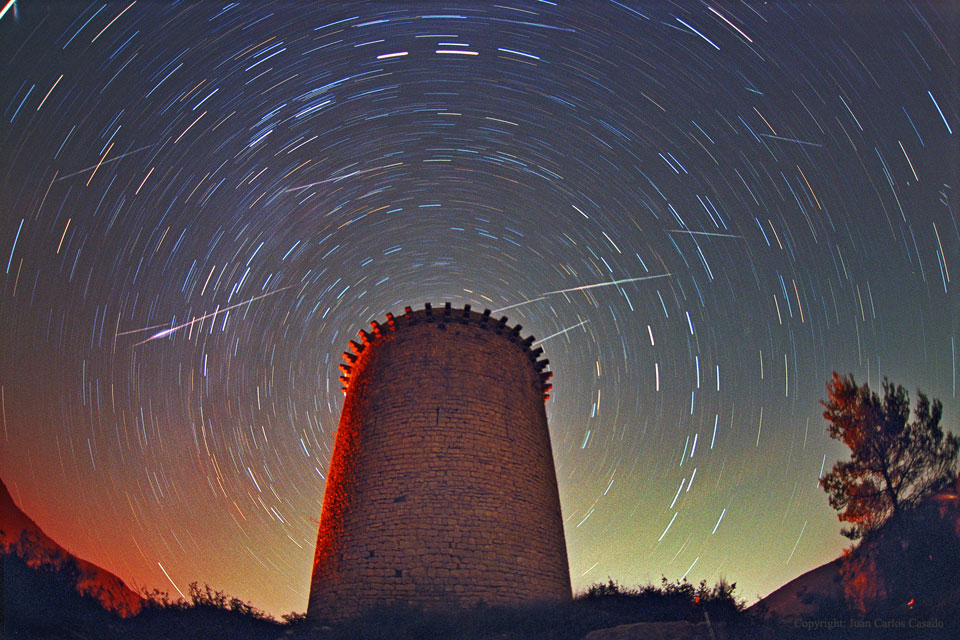토레 데 라 구아이타 위의 사자자리 유성우
설명: 사자자리 유성우는 1999년에 가장 인상적으로 증가했었다. 유럽의 관측자들은 11월 18일 UTC 기준 2시 10분의 이른 새벽녁에 눈에 띄게 갑자기 많은 수의 쏟아진 유성우를 보았다. 그 때는 실제로 유성 폭풍으로 정의되는, 최소 수에 해당되는 시간당 1000개 이상의 유성들이 보였다. 세계 전역의 다른 시간과 다른 장소에서는 보통 시간당 30에서 100개 정도로 꽤 괜찮은 기록들이 보고되었다. 이 사진은 주된 사자자리 유성우가 절정에 달하기 직전 20분간 셔터를 열고 노출을 통해 담아낸 장면이다. 12세기에 사용되었던 스페인 기로나(Girona)에 위치한 관측대 토레 데 라 구아이타(Torre de la Guaita) 위로 하늘 높이 스치고 지나간 사자자리 유성우가 남긴 흔적을 최소 5개 찾을 수 있다. 2014년, 며칠 밤이 지나면 사자자리 유성우는 다시 절정이 될 것이다. 올해 비록 초승달이 하늘에 많은 영향을 주지 않더라도 지구가 1999년 보다는 템펠-터틀(Tempel-Tuttle) 혜성의 찌꺼기가 보다 평범하게 남겨진 찌꺼기 흐름을 통과할 것으로 예상되므로, 올해는 아마도 어두운 지역에서 많아야 시간 당 15개 가량의 눈에 띄는 유성우가 나타날 것이다.
원문 출처: http://apod.nasa.gov/apod/ap141116.html
Astronomy Picture of the Day
Discover the cosmos! Each day a different image or photograph of our fascinating universe is featured, along with a brief explanation written by a professional astronomer.
2014 November 16
Image Credit & Copyright: Juan Carlos Casado (TWAN)
Explanation: Leonids Meteor Shower came to an impressive crescendo in 1999. Observers in Europe saw a sharp peak in the number of meteors visible around 0210 UTC during the early morning hours of November 18. Meteor counts then exceeded 1000 per hour - the minimum needed to define a true meteor storm. At other times and from other locations around the world, observers typically reported respectable rates of between 30 and 100 meteors per hour. This photograph is a 20-minute exposure ending just before the main Leonids peak began. Visible are at least five Leonid meteors streaking high above the Torre de la Guaita, an observation tower used during the 12th century in Girona, Spain. In 2014, over the next few nights, the Leonids meteor shower will again peak. This year, although the crescent Moon should not create much competing skyglow, the Earth is predicted to pass through a more moderate stream of debris left over from Comet Tempel-Tuttle than in 1999, perhaps resulting in as many as 15 visible meteors per hour from dark locations.
Tomorrow's picture: open space'국문 APOD > 2014' 카테고리의 다른 글
| [APOD] 올챙이 성운에서 별이 탄생하다.(2014.11.18.) (0) | 2014.11.18 |
|---|---|
| [APOD] HD 95086의 이중 먼지원반(2014.11.17.) (0) | 2014.11.17 |
| [APOD] 튤립성운(2014.11.15) (0) | 2014.11.15 |
| [APOD]혜성에 온 것을 환영합니다.(2014.11.14) (0) | 2014.11.14 |
| [APOD] 혜성에 연착륙(2014.11.13.) (0) | 2014.11.13 |
